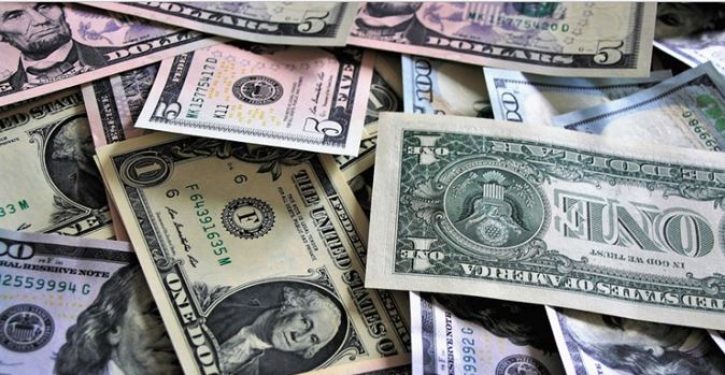
Today, Joe Biden announced a plan to write off $10,000 in student loans for most people who haven’t paid off their student loans — and $20,000 in student loans for people who received Pell Grants. Biden’s plan will increase inflation, inequality, tuition, and the national debt.
News articles have estimated the cost of Biden’s plan at around $300 billion. But that’s an underestimate. Earlier estimates of the cost of student loan forgiveness pegged its cost at $330 billion ($2,100 per taxpayer). But that was based on the assumption that a maximum of $10,000 would be written off, not the higher amount of $20,000, as Biden has now made clear will be written off for millions of student loan borrowers with Pell Grants. Increasing their write-off to $20,000 will cost over $100 billion, because “Pell Grant recipients are more than 60% of the borrower population. The Department of Education estimates that roughly 27 million borrowers will be eligible to receive up to $20,000 in relief.” Moreover, Biden also announced an extension of the student loan repayment moratorium for even those loans he didn’t write off. That will cost billions of dollars more, because the suspension of student loan repayments costs taxpayers over $52 billion per year.
Moreover, Biden did something far more momentous today than just a one-time write-off of $300 billion in student loans. He announced the Education Department’s intent to revise income-driven repayment plans in a way that would allow students who foolishly attend expensive colleges to largely avoid repaying their loans, by cutting their payments by well over half. As a result, many borrowers will pay only a trivial amount each month, and can stop paying anything at all after 10 or 20 years, no matter how much of their student loan balance remains. The remaining student loan balance will be written off, at taxpayer expense. That could eventually cost over a trillion dollars. It will also encourage colleges to raise tuition like crazy, because “under income-based repayment, your payments vary with your income, not the size of the loan” you took out to pay for tuition.
$1.6 trillion in student loans are outstanding, and the amount continues to rise rapidly, especially with students expecting that the government may write off more loans in the future, which encourages them to take out yet more student loans. As Saagar Enjeti notes, even if the government cancels $10,000 per borrower this year, “the amount of outstanding debt will return to today’s levels in just 4 years,” thanks to all the steadily-rising student loans people are taking out each year. But Biden’s changes to income-based repayment plans would write off much of this $2 trillion in student loans, in the future, as more and more students take advantage of them.
The White House “Fact Sheet” explains the radical changes it plans to these repayment plans:
The Department of Education has the authority to create income-driven repayment plans, which cap what borrowers pay each month based on a percentage of their discretionary income. Most of these plans cancel a borrower’s remaining debt once they make 20 years of monthly payments….the Department of Education is proposing a rule to do the following:
- For undergraduate loans, cut in half the amount that borrowers have to pay each month from 10% to 5% of discretionary income.
- Raise the amount of income that is considered non-discretionary income and therefore is protected from repayment, guaranteeing that no borrower earning under 225% of the federal poverty level—about the annual equivalent of a $15 minimum wage for a single borrower—will have to make a monthly payment.
- Forgive loan balances after 10 years of payments, instead of 20 years, for borrowers with original loan balances of $12,000 or less.
As the White House notes, this would largely wipe out loan repayments by many borrowers who are “typical” of their occupation — it gives the example of one borrower who “would pay only $56 a month on their loans, compared to the $197 they pay now,” and another who “would pay only $61 a month on their undergraduate loans, compared to the $295 they pay now.” If you borrow a huge amount of money to attend a fancy college with pallatial facilities, and end up with a steady job after graduation, then you should have to pay back more than a measly $56 per month.
The White House claims that it “has the authority” to do this. But setting monthly payments at an amount that is obviously too low to ever repay most of a student’s loans seems inconsistent with “Congress’ original vision for income-driven repayment,” contrary to the White House’s claims.
Even without the White House cutting payments in half, clever colleges were already using income-based repayment plans to rip off taxpayers and make them pay the inflated tuition of students getting fancy degrees. A 2013 article in The Washington Post explained “how Georgetown Law gets Uncle Sam to pay its students’ bills,” averaging $158,888 over three years, taking advantage of perverse incentives in a federal student-loan program. A federal income-based repayment plan forgives the student loan debt of law students who go to work for the government or a “public interest” law firm 10 years after they graduate, as long as they pay a small percentage of their income in the first ten years after graduation towards paying off part of their student loans. Typically, much of those law students’ loans are not paid off by the end of 10 years, and thus are forgiven at taxpayer expense. But Georgetown figured out a way to take things even further and make taxpayers pick up the entire tab through creative accounting, “not only tuition and fees but living expenses like housing and food.” Every dollar Georgetown charged in increased tuition came from taxpayers, not students, because “under income-based repayment, your payments vary with your income, not the size of the loan.”
The cost of student loan forgiveness will be paid for through higher taxes, or — more likely — more government borrowing, increasing a national debt that is already far bigger than our economy.
As the College Fix notes, “An analysis from the Texas Public Policy Foundation concluded that an executive order bailout is likely illegal. Alan Dershowitz, professor emeritus at Harvard Law school, has also said that a student bailout through executive action would be illegal.”
It is also profoundly regressive. As Greg Price notes, “Only 37% of Americans have a 4-yr college degree, only 13% have graduate degrees, and a full 56% of student loan debt is held by people who went to grad school. Biden’s plan to cancel it would be like taking money from a plumber to pay the debt of a lawyer.”
The National Review’s Charles Cooke says writing off student loans is both regressive and illegal: “The people with the lowest unemployment rate in the country” — college graduates — “took out the loans, spent them, and received a product for the money. Joe Biden intends to violate his oath of office to transfer the liability for repayment to the people who didn’t do any of that.”
Even Democratic economists and academics have expressed skepticism about writing off student loans, saying that it will increase inflation and economic inequality. Yesterday, former Treasury Secretary and Harvard University president Lawrence H. Summers noted that “Student loan debt relief is spending that raises demand and increases inflation. It consumes resources that could be better used helping those who did not, for whatever reason, have the chance to attend college. It will also tend to be inflationary by raising tuitions.” “Every dollar spent on student loan relief is a dollar that could have gone to support those who don’t get the opportunity to go to college.”
As the College Fix notes,
Summers is the latest economist to warn about the problems with student debt bailouts. Two finance professors wrote in July that it would be “bad policy” and “bad economics” to provide an expansive bailout to borrowers. Mitch Daniels, the president of Purdue University and the former Office of Management and Budget director under President George W. Bush, called the idea “fatally flawed.” “This is another very regressive suggestion, they’re going to give money to people making three times the national median average,” Daniels told CNBC on May 31.
It’s “a giveaway to people who don’t need it and who freely took these obligations on,” Daniels said.
Writing off student loans will encourage colleges to raise tuition, by making it more attractive to take out big loans to cover college tuition. When students are willing to borrow more to go to college, colleges respond by increasing tuition. The Daily Caller notes that “each additional dollar in government financial aid translated to a tuition hike of about 65 cents,” according to the Federal Reserve Bank of New York.
Biden’s suspension of student loan repayments bothers not just conservatives, but even some progressives. Former Harvard president Summers calls suspending student loan payments the “worst idea” because it transfers wealth to “highly paid surgeons, lawyers and investment bankers.”
Inflation and inequality are getting worse due to the suspension, says Matthew Yglesias, who co-founded the progressive website Vox, and wrote for Slate and The American Prospect.
In the Washington Post, Yglesias notes that the long pause in student loan payments since 2020 has disproportionately benefited the wealthy, at the expense of taxpayers who mostly don’t have college degrees, and don’t have student loans:
“Between canceled interest and the erosion of principal due to inflation, the prolonged pause has already saved student debtors a bunch of money. But the benefits are awfully lopsided. As Marc Goldwein of the Committee for a Responsible Federal Budget shows, medical doctors have received $48,500 in relief versus $29,500 for people with law degrees, $4,500 for people with bachelor’s degrees, and a measly $2,000 for those who didn’t finish their degree and are objectively most in need of help.”
Yglesias says that Biden’s suspension of student loan repayments will drive up the inflation rate:
“Most Americans say the most important problem facing the country is inflation — and President Joe Biden just made it worse. His administration announced last week it would extend yet again the emergency suspension of student loan repayments, even as his frenemies on the left are urging a program of complete forgiveness of all student debt.”
Rapid inflation is already occurring due to massive government spending, he says, and student loan forgiveness will make matters worse:
“That gigantic fiscal infusion [Biden’s $1.8 trillion stimulus package] supercharged demand in 2021…putting inflationary pressure on the economy. Pressure then got superdupercharged by Russia’s invasion of Ukraine and the ensuing sanctions…..The economy no longer needs stimulus — in fact, it needs to restrain demand….So to the extent that it’s possible to reduce inflation by directly curtailing consumption, that can be helpful. And the most progressive approach is to curtail the consumption of the affluent….Non-collection of student loans, meanwhile, has the opposite effect…restarting loan payments would drain some demand out of the economy, and would do so by disproportionately targeting those most able to pay….Restarting student debt collections would restrain inflation at the expense of a disproportionately high-income minority of the population. Broad debt cancellation, by contrast, would boost inflation.”
Inflation is much higher in the U.S. than in many other countries. The U.S. inflation rate is 8.5%, and wholesale price inflation has reached double digits in the U.S. By contrast, in Japan, the inflation rate is only 2.6%. In Switzerland, it’s 3.4%.
Andrew Gillen of the Texas Public Policy Foundation argues that it is illegal for Biden to write off student loans or cancel student loan obligations, because that is beyond what Congress authorized presidents to do, and relies on a loophole that doesn’t apply to post-2010 student loans. Financial aid expert Mark Kantrowitz also argues that student loan forgiveness by executive order is illegal.
An economic adviser to President Obama said Joe Biden’s anticipated $10,000-per-borrower student loan bailout would be a “huge mistake.” Katherine Abraham was on Obama’s Council of Economic Advisers, and is currently an economics professor at the University of Maryland. For 8 years, she served as Commissioner of the Bureau of Labor Statistics. In May, she co-authored a critique of Biden’s anticipated bailout in Politico. In it, she and Michael Strain, an economist at the American Enterprise Institute, wrote:
Blanket forgiveness of student loans, as President Joe Biden appears poised to offer, would be a huge mistake. It’s regressive and unfair. Over time, it could well increase the number of people struggling with student debt. And while billed as a “one time” policy, it would set a terrible precedent. This is not to say there aren’t student borrowers who need help. But there are better ways to support them than a giveaway that would primarily benefit well-off professionals.
Making taxpayers pick up the tab for $10,000 in student loans per borrower is “extremely regressive,” explained the two economists. “Relatively few low-income households have student debt and, among those who do, outstanding loan balances are smaller than for higher-income borrowers.” Writing off student loans violates fundamental principles of fairness:
One of the bedrock principles of sound economic policy is that similarly situated people should be treated similarly. Student loan forgiveness would take a hatchet to this principle. It would be a slap in the face to individuals from modest backgrounds who attended college but never took on debt or have already paid it off. What would the administration say to a person who struggled for years to pay off her student loans, finally becoming debt free last month? Or to the people who chose to attend their local community college rather than a more expensive four-year college because they did not want to borrow? Or to the people who avoided debt by serving in the military to qualify for GI Bill benefits?
A bailout by taxpayers creates a moral hazard, where future borrowers would expect to be bailed out, too: “Student loan forgiveness sets a terrible precedent as well. Because future students might reasonably expect their debt to be forgiven too, there is a real risk it would encourage excessive borrowing.”



